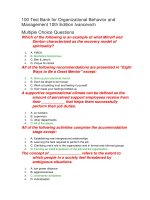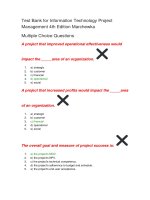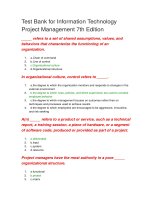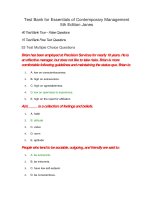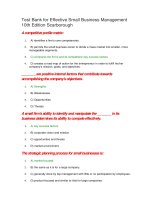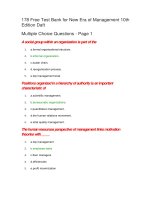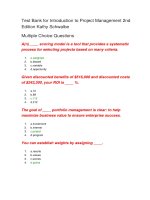Test bank for information technology project management 4th edition marchewka
Bạn đang xem bản rút gọn của tài liệu. Xem và tải ngay bản đầy đủ của tài liệu tại đây (107.56 KB, 22 trang )
Test Bank for Information Technology Project
Management 4th Edition Marchewka
Multiple Choice Questions
A project that improved operational effectiveness would
impact the _____area of an organization.
1.
2.
3.
4.
5.
a) strategic
b) customer
c) financial
d) operational
e) social
A project that increased profits would impact the _____area
of an organization.
1.
2.
3.
4.
5.
a) strategic
b) customer
c) financial
d) operational
e) social
The overall goal and measure of project success is:
1.
2.
3.
4.
5.
a) the project's MOV.
b) the project's NPV.
c) the project's technical competency.
d) the project's adherence to budget and schedule.
e) the project's end-user acceptance.
The _____ infrastructure supports the project in terms of the
environment and team itself.
1.
a) organizational
2.
3.
4.
5.
b) project
c) technical
d) process
e) control
How many widgets would a company have to sell if their
initial investment was $60,000 and widgets sold for
$25? Materials to produce 100 widgets cost $1000.
Direct labor costs $2.50 per widget. Total indirect costs
& overhead is 10% of the selling price.
1.
2.
3.
4.
5.
a) 4,800
b) 6,000
c) 8,000
d) 8,142
e) Not enough information to calculate.
The first stage of the IT project methodology focuses
on:
1.
2.
3.
4.
5.
a) choosing the project team members.
b) defining the overall goal of the project.
c) conceptualizing alternative approaches to project development.
d) identifying the project's scope.
e) identifying project managers and sponsors.
Which of the following is the best MOV statement?
1.
2.
3.
4.
5.
a) Our project should make Dayton customers flock to the stores in droves to buy
our products.
b) Our project should be completed in no more than 180 days and should cost no
more than $150,000 and be completed 100% in-house.
c) Our project should increase sales in the Dayton market by 15% next year to
complete our company's Ohio expansion strategy.
d) Our project should utilize the Spiral Development approach to eliminate 95% of
the major risks to our Dayton sales program.
e) Our project should produce an advertising campaign in Dayton that wins the
Ohio Advertising Guild's Award for most creative campaign.
The IT project management foundation includes all of the
following except:
1.
2.
3.
4.
5.
a) PM processes
b) PM objectives
c) PM methodologies
d) PM tools
e) PMBOK® knowledge areas
Which of the following is NOT a perspective from the
Balanced Scorecard Approach?:
1.
2.
3.
4.
5.
a) Financial Perspective
b) Internal Processes Perspective
c) Innovation & Learning Perspective
d) Customer Perspective
e) Organizational Value Perspective
A project that increased market share would impact the
_____area of an organization.
1.
2.
3.
4.
5.
a) strategic
b) customer
c) financial
d) operational
e) social
The _____ infrastructure supports and manages the project
within the organization.
1.
2.
3.
4.
5.
a) organizational
b) project
c) technical
d) process
e) control
Evaluating the feasibility of an alternative in terms of the
funds and resources available to support a project for
the organization is a measure of _____.
1.
2.
3.
4.
5.
a) organizational feasibility
b) technical feasibility
c) economic feasibility
d) legal feasibility
e) ethical feasibility
_____ provides all the tactical details concerning who will
carry out the work and when it will be
accomplished.
1.
2.
3.
4.
5.
a) Business case
b) Strategic plan
c) Initiating process
d) Project plan
e) project charter
Verification of all project deliverables occurs during
___.
1.
2.
3.
4.
5.
a) Conceptualize and initialize the project (Phase 1)
b) Develop the project charter and plan (Phase 2)
c) Execute and control (Phase 3)
d) Close project (Phase 4)
e) Evaluate project success (Phase 5)
The text cites all of the following as reasons supporting the
selection of an IT project except:
1.
2.
a) The project is doable and worth doing
b) The project maps directly to the organization's strategies and goals
3.
4.
5.
c) The project provides measurable organizational value.
d) The project represents a cutting edge technology that fits the team skill set.
e) The project ranks favorably based on the companies adaptation of the Balanced
Scorecard Approach.
A company utilizes the payback method exclusively to select
projects. Which of the following mutually exclusive
(they can only do one of them) projects will they
choose? (Assume cash flows occur in equal monthly
installments)
1.
2.
3.
4.
5.
a) Initial Investment: $10,000 Net Cash Flows: year 1:$0 year 2:$120,000 year
3:$60,000 each year thereafter:$60,000
b) Initial Investment:$100,000 Net Cash Flows: year 1:$50,000 year 2:$50,000
year 3:$100,000 each year thereafter:$1,000,000
c) Initial Investment:$10,000 Net Cash Flows: year 1:0 year 2:$100,000 year
3:$100,000 each year thereafter:$100,000
d) Initial Investment:$100,000 Net Cash Flows: year 1:$1,000,000 year
2:$2,000,000 year 3:$2,000,000 each year thereafter:0
e) Initial Investment:$10,000 Net Cash Flows: year 1:$8,000 year 2:$12,000 year
3:$120,000 each year thereafter:$120,000
The _________ gives authority to the project manager to
begin carrying out the processes and tasks associated
with the systems development life cycle .
1.
2.
3.
4.
5.
a) business case
b) project sponsor
c) initiating process
d) implementation plan
e) project charter
Scope and schedule are examples of:
1.
2.
3.
4.
5.
a) Project Management processes.
b) Project Management tools.
c) PMBOK® areas of knowledge
d) Project Management objectives
e) Project Management infrastructure.
Calculate the ROI for a project with total expected costs of
$40,000 and total expected benefits of 35,000.
1.
2.
3.
4.
5.
a) -12.5%
b) 12.5%
c) 1.875%
d) 187.5%
e) -18.75%
All of the following are steps in developing the project MOV
except:
1.
2.
3.
4.
5.
a) Identify the available organizational resources.
b) Identify the desired value of the IT project.
c) Develop an appropriate metric.
d) Set a time frame for achieving MOV.
e) Verify and get agreement from project stakeholders.
Which of the following statements about the business case
is NOT true:
1.
2.
a) A business case provides an analysis of feasibility
b) A business case provides senior management with sufficient information to fund
a project.
3. c) A business case provides details of possible impacts, costs and benefits.
4. d) A business case provides a project budget.
5. e) A business case may be a large, formal document.
Evaluating the feasibility of an alternative in terms of the
funds and resources available to support a project for
the organization is a measure of _____.
1.
2.
a) organizational feasibility
b) technical feasibility
3.
4.
5.
c) economic feasibility
d) legal feasibility
e) ethical feasibility
A project that provided customers better products and
services would impact the _____area of an
organization.
1.
2.
3.
4.
5.
a) strategic
b) customer
c) financial
d) operational
e) social
Which of the following was NOT given as a reason for
recruiting a core team to develop the business
case?
1.
2.
3.
4.
5.
a) enhanced credibility
b) alignment with organizational goals
c) access to real costs
d) early identification of project team.
e) shared sense of ownership
The project charter is a key deliverable from ________ and
addresses, along with other questions,
________:
1.
2.
3.
4.
5.
a) phase 1, How long will this project take
b) phase 1, Who is the project sponsor?
c) phase 5, What scope controls will be used?
d) phase 2, How much will the project cost?
e) phase 3, A detailed risk plan.
The _____ infrastructure provides the hardware and software
tools to support the project team.
1.
2.
3.
4.
5.
a) organizational
b) project
c) technical
d) process
e) control
Which of the following statements is the best indicator that
the new software project was successful.
1.
2.
3.
4.
5.
a) The project's product, a software system, was enthusiastically accepted by
100% of the end users who were able to begin using it after completing only a oneday training session.
b) The project's product, a software system, was a week late and 2% over budget,
but six months later was found to have met the company's goal of reducing service
callbacks by 15%.
c) The project's product, a software system, was completed two weeks ahead of
time freeing up the entire development team to begin work on other projects.
d) The project's product, a software system, was completed right on schedule and
was delivered $10,000 under the $100,000 budget allocation.
e) The project's product, a software system, was completed on time and on budget
and was tested and shown to be 100% bug-free.
Calculate the Net Present Value for a project with the
following cash flows: Year 0: ($5,000) Year 1: $10,000
Year 2: $10,000 Year3: ($2,000). The discount rate is
5%.
1.
2.
3.
4.
5.
a) $19,209.75
b) $14,209.75
c) $18,840.25
d) $23,840.25
e) $12,350.00
Determining whether the proposed solution will work within
the software architecture is a measure of
_____.
1.
2.
3.
4.
5.
a) organizational feasibility
b) technical feasibility
c) economic feasibility
d) legal feasibility
e) ethical feasibility
A project that provided cleaner air would impact the
_____area of an organization.
1.
2.
3.
4.
5.
a) strategic
b) customer
c) financial
d) operational
e) social
_____ focuses on carrying out the project plan to deliver the
IT product and managing the project to achieve the
goal.
1.
2.
3.
4.
5.
a) Conceptualize and initialize the project (Phase 1)
b) Develop the project charter and plan (Phase 2)
c) Execute and control (Phase 3)
d) Close project (Phase 4)
e) Evaluate project success (Phase 5)
An Information Technology Project Methodology
( ITPM )
1.
a) is an alternative metric for deciding between competing projects.
2.
b) is a six-phase program described by PMBOK® and offered as a generally
accepted industry practice.
3. c) is specified by parameters of the business case.
4. d) is a set of deliverables derived from the various PLC phases.
5. e) is a strategic-level plan for managing and controlling IT projects.
Planning, executing, and controlling are examples
of:
1.
2.
3.
4.
5.
a) Project Management process groups.
b) Project Management tools.
c) PMBOK® areas of knowledge
d) Project Management objectives
e) Project Management infrastructure.
The business case is the key deliverable for:
1.
2.
3.
4.
5.
a) phase 1.
b) phase 2.
c) phase 3.
d) phase 4.
e) phase 5.
Determining whether employees will be able to adapt to the
planned change is _____.
1.
2.
3.
4.
5.
a) organizational feasibility
b) technical feasibility
c) economic feasibility
d) legal feasibility
e) ethical feasibility
True - False Questions
The Balance Scorecard approach employs four perspectives
for analyzing project benefits: Financial Perspective,
Customer Perspective, Competitor Perspective, and
Internal Processes Perspective.
1.
2.
True
False
The SDLC (systems development life cycle) is a deliverable
from the project charter.
1.
2.
True
False
The total cost of ownership (TCO) includes only the direct or
up-front costs and ongoing expenditures.
1.
2.
True
False
Feasibility focuses on whether a particular alternative is
doable and worth doing.
1.
2.
True
False
Project Management processes include Scope, Schedule,
Budget, and Quality.
1.
2.
True
False
All cash flows over the useful life of a project alternative
must be included in the payback method of
analysis.
1.
2.
True
False
Feasibility focuses on what can go wrong and what must go
right.
1.
2.
True
False
The MOV should explicitly state the technology that will
support the IT project.
1.
2.
True
False
The MOV should be adjusted at each phase of a project to
align with the realities of project execution.
1.
2.
True
False
Scoring models are useful because they allow for the
inclusion of qualitative factors.
1.
2.
True
False
A methodology provides a strategic-level plan for managing
and controlling IT projects.
1.
2.
True
False
A scoring model can combine both qualitative items based
reflected in the weights and scores that are based on
people’s judgments.
1.
2.
True
False
For the sake of efficiency and unity of purpose and direction,
it is usually advisable to have the project manager take
sole responsibility for developing the business
case.
1.
2.
True
False
In general, riskier project alternatives will have a lower
breakeven point than less risky project
alternatives.
1.
2.
True
False
The primary focus of “the conceptualize and initialize phase”
is to determine the overall goal of the project.
1.
2.
True
False
The total benefits of ownership (TBO) should address the
benefits of an alternative over its useful life.
1.
2.
True
False
A business case is a deliverable that documents the
project’s goal, as well as several alternatives or
options.
1.
2.
True
False
The project charter is a key deliverable for the second phase
of the IT project methodology.
1.
2.
True
False
A significant deficiency of the payback method of analyzing
alternatives is the failure to account for the time value
of money.
1.
2.
True
False
The net present value method of project valuation takes into
account all relevant cash flows as well as the
company’s required rate of return.
1.
2.
True
False
Free Text Questions
Describe the five project management processes.
Answer Given
• Initiating processes—to start or initiate a project or phase once commitment is
obtained: • Planning processes—to develop and maintain a workable plan to support
the project’s overall goal; • Executing processes—to coordinate people and other
resources to execute the plan; • Controlling processes—to ensure proper control and
reporting mechanisms are in place so that progress can be monitored, problems
identified, and appropriate actions taken when necessary; • Closing processes—to
provide closure in terms of a formal acceptance that the project or a project’s phase
has been completed satisfactorily.
Describe the five phases of the IT project methodology.
Answer Given
• Phase 1: Conceptualize and Initialize: This phase focuses on defining the overall
goal of the project. Alternatives that would allow the organization to meet its goal are
then identified. Next, the costs and benefits, as well as feasibility and risk, of each
alternative are analyzed. Based upon these analyses, a specific alternative is
recommended for funding. Finally, the project’s goal and the analysis of alternatives
that support the goal are summarized in a deliverable called the business case; •
Phase 2: Develop the Project Charter and Detailed Project Plan: The project charter
is a key deliverable for the second phase. The project charter clarifies the project’s
goal and defines the project’s objectives in terms of scope, schedule, budget, and
quality standards. In addition, the project charter identifies and gives authority to a
project manager to begin carrying out the processes and tasks associated with
SDLC. The project plan provides all the tactical details concerning who will carry out
the project work and when. Additionally, the project’s scope, schedule, budget, and
quality objectives are defined in detail; • Phase 3: Execute and Control the Project:
focuses on execution and control—carrying out the project plan in order to deliver the
IT product and managing the project’s processes in order to achieve the project’s
goal. During this phase the project team uses a particular approach and set of
systems analysis and design tools for implementing the systems development life
cycle (SDLC). In addition, the project manager must ensure that the environment and
infrastructure support the project; • Phase 4: Close Project: After the information
system has been developed, tested, and installed, a formal acceptance should
transfer control from the project team to the client or project sponsor. The project
team should prepare a final project report and presentation to document and verify
that all the project deliverables have been completed as defined in the project’s
scope; • Phase 5: Evaluate Project Success: this phase focuses on evaluating four
areas: o First, a “postmortem,” or final project review, should be conducted by the
project manager and team; o Second, an evaluation between the project manager
and the individual project team members is conducted; o Third, an outside third party
should review the project, the project manager, and project team; o Fourth, the
project must be evaluated in order to determine whether the project provided value to
the organization.
What are the advantages of having and following a project
methodology?
Answer Given
• Methodologies provide the project team with a game plan for implementing the
project and product life cycles so that the team can focus on the tasks at hand,
instead of always worrying about what they are supposed to do next; A methodology
provides a common language that allows the project team, project sponsor, and
others within the organization to communicate more effectively; • A standardized
methodology allows management to compare different projects more objectively
which in turn will allow management to make better-informed and more objective
decisions with respect to which projects get selected and whether funding should
continue to support a particular project.
What is a project infrastructure?
Answer Given
The project infrastructure supports the project team in terms of the project
environment and the project team itself. It includes: o The project environment—The
physical workspace for the team to meet and work; o Roles and responsibilities of the
team members —This determines the reporting relationships, as well as the
responsibilities and authorities of the individual team members; o Processes and
controls—Processes and controls provide support for managing all aspects of the
project. They ensure that the project’s goal and objectives are being met.
What is a project charter?
Answer Given
The project charter is a key deliverable for the second phase of the IT project
methodology. It defines how the project will be organized and how the project
alternative that was recommended and approved for funding will be implemented.
The project charter provides another opportunity to clarify the project’s goal and
defines the project’s objectives in terms of scope, schedule, budget, and quality
standards. In addition, the project charter identifies and gives authority to a project
manager to begin carrying out the processes and tasks associated with the systems
development life cycle (SDLC).
Describe how a project’s MOV can support an organization’s
goals and strategies.
Answer Given
As shown by the IT Value Chain, an organizational goal leads to or defines certain
organizational strategies. A project’s MOV should be designed to align with and
support those strategies. At the project’s end, the project’s results can be compared
to the initial MOV. With a successful project, one should see successful execution of
organizational strategies and a measurable realization of some organizational goal.
Discuss how the project management knowledge areas
support the IT project methodology.
Answer Given
The Project Management Body of Knowledge (PMBOK®) encompasses nine areas
generally accepted as having merit for effectively managing projects. These nine
areas support both the project processes and product by providing a foundation of
knowledge for supporting projects within a particular organization. As an organization
gains more experience with projects over time, the lessons learned from every
project contribute to each of these nine areas. Ideally, these lessons will lead to an IT
project management knowledge base that can be used to identify best practices that
adapt the IT project methodology to an organization’s needs, culture, and IT project
environment. This base of knowledge can then be institutionalized throughout the
organization and its projects.
Describe the criteria that should be used to make a project
selection decision.
Answer Given
The decision to approve an IT project requires a number of conditions be met: • The
IT project must map directly to the organization’s strategies and goals; • The IT
project must provide measurable organizational value that can be verified at the
completion of the project; • The selection of an IT project should be based upon
diversity of measures that include: o Tangible costs and benefit; o Intangible costs
and benefit; o Various levels throughout the organization (e.g., individual, process,
department, and enterprise)
What is Total Cost of Ownership?
Answer Given
(TCO) is a concept that has gained widespread attention in recent years and
generally refers to the total cost of acquiring, developing, maintaining, and supporting
the application system over its useful life. TCO includes such costs as: • Direct or upfront costs—Initial purchase price of all hardware, software, and telecommunications
equipment, all development or installation costs, outside consultant fees, etc; •
Ongoing costs—Salaries, training, upgrades, supplies, maintenance, etc; • Indirect
costs—Initial loss of productivity, time lost by users when the system is down, the
cost of auditing equipment (i.e., finding out who has what and where), quality
assurance, and post implementation reviews.
What is a business case?
Answer Given
A business case is the first deliverable in the IT project life cycle. It provides an
analysis of the organizational value, feasibility, costs, benefits, and risks of several
proposed alternatives or options.
